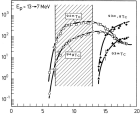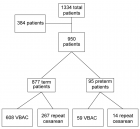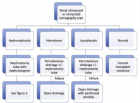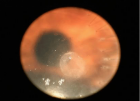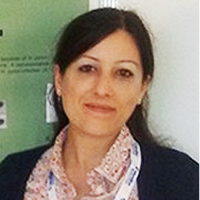Abstract
Research Article
The Predictive Value of Diaphragm Thickness Fraction on Postoperative Pulmonary Complications after Digestive Cancer Curative Surgery
Oussama Ssouni*, Abdelilah Ghannam, Brahim El-Ahmadi, Zakaria Belkhadir, Khalid Abidi, Amal Bouziane and Redouane Abouqal
Published: 14 August, 2023 | Volume 7 - Issue 2 | Pages: 035-045
Background: Postoperative Pulmonary Complications (PPCs) escalate mortality, hospitalization, and costs. This study aimed to predict PPCs after curative digestive cancer surgery using thickness fraction (TFdi) determined by ultrasonography.
Methods: A prospective study was conducted over a period of 9 months. Diaphragmatic ultrasound was performed pre-surgery and repeated postoperatively (within 24 hours of ICU admission, then day 3). Right and left hemidiaphragm thickness at end-expiration (TEE) and peak-inspiration (TPI) were measured using ultrasonography. The maximal diaphragm thickening fraction during inspiration (TFdi,max) was calculated: TFdi,max = (TPI–TEE)/TEE. Patients were classified into No-PPCs and PPCs groups.
Results: 159 patients participated, 55 (34.6%) developed PPCs. ICU stay was longer in PPCs patients with more deaths. TFdi,max decreased postoperatively and remained lower in PPCs patients [44.83% ± 11.07 vs. 31.54% ± 8.45; p < 0.001]. The receiver operating characteristic curve yielded an area under the curve of 0.83 [95% IC: 0.754 – 0.887]. TFdi,max < 37% had 72.7% sensitivity (95% IC: 59.0% – 83.8%) and 80.8% specificity (95% IC: 71.8% – 87.8%), Positive and negative Likelihood Ratios were 3.7 (95% IC: 2.4 – 5.7) and 0.3 (95% IC:0.2 – 0.5), respectively. In multiple logistic regression, preoperative risk factors for PPCs included TFdi,max
< 37% [OR: 7.10; 95% CI: 1.71 – 18.60; p < 0.001] and supramesocolic surgery [OR: 9.94; 95% CI: 3.62 – 27.29;
p < 0.001]. Epidural administration was protective [OR: 0.21; 95% CI: 0.052 – 0.87; p = 0.031].
Conclusion: A low preoperative TFdi,max identifies high-risk PPCs patients after digestive cancer surgery, aiding targeted preventive strategies like inspiratory muscle preoperative training.
Read Full Article HTML DOI: 10.29328/journal.ascr.1001072 Cite this Article Read Full Article PDF
Keywords:
Postoperative pulmonary complications; Digestive cancer curative surgery; Diaphragm thickness fraction; Ultrasonography
References
- Miskovic A, Lumb AB. Postoperative pulmonary complications. Br J Anaesth. 2017 Mar 1;118(3):317-334. doi: 10.1093/bja/aex002. PMID: 28186222.
- Smetana GW, Lawrence VA, Cornell JE; American College of Physicians. Preoperative pulmonary risk stratification for noncardiothoracic surgery: systematic review for the American College of Physicians. Ann Intern Med. 2006 Apr 18;144(8):581-95. doi: 10.7326/0003-4819-144-8-200604180-00009. PMID: 16618956.
- Herbstreit F, Peters J, Eikermann M. Impaired upper airway integrity by residual neuromuscular blockade: increased airway collapsibility and blunted genioglossus muscle activity in response to negative pharyngeal pressure. Anesthesiology. 2009 Jun;110(6):1253-60. doi: 10.1097/ALN.0b013e31819faa71. PMID: 19417617.
- Bablekos GD, Michaelides SA, Analitis A, Charalabopoulos KA. Effects of laparoscopic cholecystectomy on lung function: a systematic review. World J Gastroenterol. 2014 Dec 14;20(46):17603-17. doi: 10.3748/wjg.v20.i46.17603. PMID: 25516676; PMCID: PMC4265623.
- Yang CK, Teng A, Lee DY, Rose K. Pulmonary complications after major abdominal surgery: National Surgical Quality Improvement Program analysis. J Surg Res. 2015 Oct;198(2):441-9. doi: 10.1016/j.jss.2015.03.028. Epub 2015 Mar 18. PMID: 25930169.
- Kor DJ, Warner DO, Alsara A, Fernández-Pérez ER, Malinchoc M, Kashyap R, Li G, Gajic O. Derivation and diagnostic accuracy of the surgical lung injury prediction model. Anesthesiology. 2011 Jul;115(1):117-28. doi: 10.1097/ALN.0b013e31821b5839. PMID: 21694510; PMCID: PMC3986041.
- McAlister FA, Bertsch K, Man J, Bradley J, Jacka M. Incidence of and risk factors for pulmonary complications after nonthoracic surgery. Am J Respir Crit Care Med. 2005 Mar 1;171(5):514-7. doi: 10.1164/rccm.200408-1069OC. Epub 2004 Nov 24. PMID: 15563632.
- Fisher BW, Majumdar SR, McAlister FA. Predicting pulmonary complications after nonthoracic surgery: a systematic review of blinded studies. Am J Med. 2002 Feb 15;112(3):219-25. doi: 10.1016/s0002-9343(01)01082-8. PMID: 11893349.
- Smith PR, Baig MA, Brito V, Bader F, Bergman MI, Alfonso A. Postoperative pulmonary complications after laparotomy. Respiration. 2010;80(4):269-74. doi: 10.1159/000253881. Epub 2009 Oct 28. PMID: 19864881.
- Canet J, Sabaté S, Mazo V, Gallart L, de Abreu MG, Belda J, Langeron O, Hoeft A, Pelosi P; PERISCOPE group. Development and validation of a score to predict postoperative respiratory failure in a multicentre European cohort: A prospective, observational study. Eur J Anaesthesiol. 2015 Jul;32(7):458-70. doi: 10.1097/EJA.0000000000000223. PMID: 26020123.
- Lawrence VA, Hilsenbeck SG, Mulrow CD, Dhanda R, Sapp J, Page CP. Incidence and hospital stay for cardiac and pulmonary complications after abdominal surgery. J Gen Intern Med. 1995 Dec;10(12):671-8. doi: 10.1007/BF02602761. PMID: 8770719.
- Khan NA, Quan H, Bugar JM, Lemaire JB, Brant R, Ghali WA. Association of postoperative complications with hospital costs and length of stay in a tertiary care center. J Gen Intern Med. 2006 Feb;21(2):177-80. doi: 10.1111/j.1525-1497.2006.00319.x. PMID: 16606377; PMCID: PMC1484655.
- Lawrence VA, Hilsenbeck SG, Noveck H, Poses RM, Carson JL. Medical complications and outcomes after hip fracture repair. Arch Intern Med. 2002 Oct 14;162(18):2053-7. doi: 10.1001/archinte.162.18.2053. PMID: 12374513.
- Mazo V, Sabaté S, Canet J, Gallart L, de Abreu MG, Belda J, Langeron O, Hoeft A, Pelosi P. Prospective external validation of a predictive score for postoperative pulmonary complications. Anesthesiology. 2014 Aug;121(2):219-31. doi: 10.1097/ALN.0000000000000334. PMID: 24901240.
- Sundman E, Witt H, Olsson R, Ekberg O, Kuylenstierna R, Eriksson LI. The incidence and mechanisms of pharyngeal and upper esophageal dysfunction in partially paralyzed humans: pharyngeal videoradiography and simultaneous manometry after atracurium. Anesthesiology. 2000 Apr;92(4):977-84. doi: 10.1097/00000542-200004000-00014. PMID: 10754616.
- Ramachandran SK, Nafiu OO, Ghaferi A, Tremper KK, Shanks A, Kheterpal S. Independent predictors and outcomes of unanticipated early postoperative tracheal intubation after nonemergent, noncardiac surgery. Anesthesiology. 2011 Jul;115(1):44-53. doi: 10.1097/ALN.0b013e31821cf6de. PMID: 21552116.
- Khuri SF, Henderson WG, DePalma RG, Mosca C, Healey NA, Kumbhani DJ; Participants in the VA National Surgical Quality Improvement Program. Determinants of long-term survival after major surgery and the adverse effect of postoperative complications. Ann Surg. 2005 Sep;242(3):326-41; discussion 341-3. doi: 10.1097/01.sla.0000179621.33268.83. PMID: 16135919; PMCID: PMC1357741.
- Nafiu OO, Ramachandran SK, Ackwerh R, Tremper KK, Campbell DA Jr, Stanley JC. Factors associated with and consequences of unplanned post-operative intubation in elderly vascular and general surgery patients. Eur J Anaesthesiol. 2011 Mar;28(3):220-4. doi: 10.1097/EJA.0b013e328342659c. PMID: 21191304.
- Grosse-Sundrup M, Henneman JP, Sandberg WS, Bateman BT, Uribe JV, Nguyen NT, Ehrenfeld JM, Martinez EA, Kurth T, Eikermann M. Intermediate acting non-depolarizing neuromuscular blocking agents and risk of postoperative respiratory complications: prospective propensity score matched cohort study. BMJ. 2012 Oct 15;345:e6329. doi: 10.1136/bmj.e6329. PMID: 23077290; PMCID: PMC3473088.
- Serpa Neto A, Hemmes SN, Barbas CS, Beiderlinden M, Fernandez-Bustamante A, Futier E, Hollmann MW, Jaber S, Kozian A, Licker M, Lin WQ, Moine P, Scavonetto F, Schilling T, Selmo G, Severgnini P, Sprung J, Treschan T, Unzueta C, Weingarten TN, Wolthuis EK, Wrigge H, Gama de Abreu M, Pelosi P, Schultz MJ; PROVE Network investigators. Incidence of mortality and morbidity related to postoperative lung injury in patients who have undergone abdominal or thoracic surgery: a systematic review and meta-analysis. Lancet Respir Med. 2014 Dec;2(12):1007-15. doi: 10.1016/S2213-2600(14)70228-0. Epub 2014 Nov 13. Erratum in: Lancet Respir Med. 2014 Dec;2(12):e23. PMID: 25466352.
- Warner DO. Preventing postoperative pulmonary complications: the role of the anesthesiologist. Anesthesiology. 2000 May;92(5):1467-72. doi: 10.1097/00000542-200005000-00037. PMID: 10781293.
- Jaber S, Chanques G, Jung B. Postoperative noninvasive ventilation. Anesthesiology. 2010 Feb;112(2):453-61. doi: 10.1097/ALN.0b013e3181c5e5f2. PMID: 20068454.
- van Kaam AH, Lachmann RA, Herting E, De Jaegere A, van Iwaarden F, Noorduyn LA, Kok JH, Haitsma JJ, Lachmann B. Reducing atelectasis attenuates bacterial growth and translocation in experimental pneumonia. Am J Respir Crit Care Med. 2004 May 1;169(9):1046-53. doi: 10.1164/rccm.200312-1779OC. Epub 2004 Feb 20. PMID: 14977624.
- Hulzebos EH, Smit Y, Helders PP, van Meeteren NL. Preoperative physical therapy for elective cardiac surgery patients. Cochrane Database Syst Rev. 2012 Nov 14;11(11):CD010118. doi: 10.1002/14651858.CD010118.pub2. PMID: 23152283; PMCID: PMC8101691.
- Hulzebos EH, Helders PJ, Favié NJ, De Bie RA, Brutel de la Riviere A, Van Meeteren NL. Preoperative intensive inspiratory muscle training to prevent postoperative pulmonary complications in high-risk patients undergoing CABG surgery: a randomized clinical trial. JAMA. 2006 Oct 18;296(15):1851-7. doi: 10.1001/jama.296.15.1851. PMID: 17047215.
- García-Delgado M, Navarrete-Sánchez I, Colmenero M. Preventing and managing perioperative pulmonary complications following cardiac surgery. Curr Opin Anaesthesiol. 2014 Apr;27(2):146-52. doi: 10.1097/ACO.0000000000000059. PMID: 24514031.
- Zarbock A, Mueller E, Netzer S, Gabriel A, Feindt P, Kindgen-Milles D. Prophylactic nasal continuous positive airway pressure following cardiac surgery protects from postoperative pulmonary complications: a prospective, randomized, controlled trial in 500 patients. Chest. 2009 May;135(5):1252-1259. doi: 10.1378/chest.08-1602. Epub 2008 Nov 18. PMID: 19017864.
- McCool FD, Tzelepis GE. Dysfunction of the diaphragm. N Engl J Med. 2012 Mar 8;366(10):932-42. doi: 10.1056/NEJMra1007236. Erratum in: N Engl J Med. 2012 May 31;366(22):2138. PMID: 22397655.
- Matamis D, Soilemezi E, Tsagourias M, Akoumianaki E, Dimassi S, Boroli F, Richard JC, Brochard L. Sonographic evaluation of the diaphragm in critically ill patients. Technique and clinical applications. Intensive Care Med. 2013 May;39(5):801-10. doi: 10.1007/s00134-013-2823-1. Epub 2013 Jan 24. PMID: 23344830.
- Goligher EC, Laghi F, Detsky ME, Farias P, Murray A, Brace D, Brochard LJ, Bolz SS, Rubenfeld GD, Kavanagh BP, Ferguson ND. Measuring diaphragm thickness with ultrasound in mechanically ventilated patients: feasibility, reproducibility and validity. Intensive Care Med. 2015 Apr;41(4):642-9. doi: 10.1007/s00134-015-3687-3. Epub 2015 Feb 19. Erratum in: Intensive Care Med. 2015 Apr;41(4):734. Sebastien-Bolz, Steffen [corrected to Bolz, Steffen-Sebastien]. PMID: 25693448.
- Dres M, Dubé BP, Mayaux J, Delemazure J, Reuter D, Brochard L, Similowski T, Demoule A. Coexistence and Impact of Limb Muscle and Diaphragm Weakness at Time of Liberation from Mechanical Ventilation in Medical Intensive Care Unit Patients. Am J Respir Crit Care Med. 2017 Jan 1;195(1):57-66. doi: 10.1164/rccm.201602-0367OC. PMID: 27310484.
- Llamas-Álvarez AM, Tenza-Lozano EM, Latour-Pérez J. Diaphragm and Lung Ultrasound to Predict Weaning Outcome: Systematic Review and Meta-Analysis. Chest. 2017 Dec;152(6):1140-1150. doi: 10.1016/j.chest.2017.08.028. Epub 2017 Aug 31. PMID: 28864053.
- Cavayas YA, Eljaiek R, Rodrigue É, Lamarche Y, Girard M, Wang HT, Levesque S, Denault AY. Preoperative Diaphragm Function Is Associated With Postoperative Pulmonary Complications After Cardiac Surgery. Crit Care Med. 2019 Dec;47(12):e966-e974. doi: 10.1097/CCM.0000000000004027. PMID: 31609771.
- Daabiss M. American Society of Anaesthesiologists physical status classification. Indian J Anaesth. 2011 Mar;55(2):111-5. doi: 10.4103/0019-5049.79879. PMID: 21712864; PMCID: PMC3106380.
- American College of Sports Medicine. Guidelines for Graded Exercise Testing and Exercise Prescription. 3rd ed. Philadelphia: Lea & Febiger,1985.
- Summerhill EM, El-Sameed YA, Glidden TJ, McCool FD. Monitoring recovery from diaphragm paralysis with ultrasound. Chest. 2008 Mar;133(3):737-43. doi: 10.1378/chest.07-2200. Epub 2008 Jan 15. PMID: 18198248.
- Sarwal A, Walker FO, Cartwright MS. Neuromuscular ultrasound for evaluation of the diaphragm. Muscle Nerve. 2013 Mar;47(3):319-29. doi: 10.1002/mus.23671. Epub 2013 Feb 4. PMID: 23382111; PMCID: PMC3581727.
- Matamis D, Soilemezi E, Tsagourias M, Akoumianaki E, Dimassi S, Boroli F, Richard JC, Brochard L. Sonographic evaluation of the diaphragm in critically ill patients. Technique and clinical applications. Intensive Care Med. 2013 May;39(5):801-10. doi: 10.1007/s00134-013-2823-1. Epub 2013 Jan 24. PMID: 23344830.
- Tuinman PR, Jonkman AH, Dres M, Shi ZH, Goligher EC, Goffi A, de Korte C, Demoule A, Heunks L. Respiratory muscle ultrasonography: methodology, basic and advanced principles and clinical applications in ICU and ED patients-a narrative review. Intensive Care Med. 2020 Apr;46(4):594-605. doi: 10.1007/s00134-019-05892-8. Epub 2020 Jan 14. PMID: 31938825; PMCID: PMC7103016.
- National Healthcare Safety Network Team. Pneumonia (Ventilator-associated [VAP] and non-ventilator-associated Pneumonia [PNEU]) Event. In: National Healthcare Safety Network Team, editor. National Healthcare Safety Network NHSN Patient Safety Component Manual. Center for Disease Control and Prevention; 2018; 6 –1 to 6 –15.
- Society of Thoracic Surgeons. STS National Database. [cited 2018 Apr 1]. https://www.sts.org/quality-safety/performance measures/descriptions#ProlongedIntubation.
- Prasad MK, Sahay S, Varshney RK, Jheetay GS. Evaluation of risk factors for postoperative pulmonary complications after elective open upper abdominal surgery in chronic obstructive pulmonary diseases patients. J Med Soc. 2019; 33: 47-51.
- Avendano CE, Flume PA, Silvestri GA, King LB, Reed CE. Pulmonary complications after esophagectomy. Ann Thorac Surg. 2002 Mar;73(3):922-6. doi: 10.1016/s0003-4975(01)03584-6. PMID: 11899202.
- Ferguson MK, Durkin AE. Preoperative prediction of the risk of pulmonary complications after esophagectomy for cancer. J Thorac Cardiovasc Surg. 2002 Apr;123(4):661-9. doi: 10.1067/mtc.2002.120350. PMID: 11986593.
- Karl RC, Schreiber R, Boulware D, Baker S, Coppola D. Factors affecting morbidity, mortality, and survival in patients undergoing Ivor Lewis esophagogastrectomy. Ann Surg. 2000 May;231(5):635-43. doi: 10.1097/00000658-200005000-00003. PMID: 10767784; PMCID: PMC1421050.
- Doty JR, Salazar JD, Forastiere AA, Heath EI, Kleinberg L, Heitmiller RF. Postesophagectomy morbidity, mortality, and length of hospital stay after preoperative chemoradiation therapy. Ann Thorac Surg. 2002 Jul;74(1):227-31; discussion 231. doi: 10.1016/s0003-4975(02)03655-x. PMID: 12118764.
- Sabel MS, Smith JL, Nava HR, Mollen K, Douglass HO, Gibbs JF. Esophageal resection for carcinoma in patients older than 70 years. Ann Surg Oncol. 2002 Mar;9(2):210-4. doi: 10.1007/BF02557376. PMID: 11888881.
- Kinugasa S, Tachibana M, Yoshimura H, Dhar DK, Shibakita M, Ohno S, Kubota H, Masunaga R, Nagasue N. Esophageal resection in elderly esophageal carcinoma patients: improvement in postoperative complications. Ann Thorac Surg. 2001 Feb;71(2):414-8. doi: 10.1016/s0003-4975(00)02333-x. PMID: 11235680.
- Arora NS, Rochester DF. Effect of body weight and muscularity on human diaphragm muscle mass, thickness, and area. J Appl Physiol Respir Environ Exerc Physiol. 1982 Jan;52(1):64-70. doi: 10.1152/jappl.1982.52.1.64. PMID: 7061279.
- Fan ST, Lau WY, Yip WC, Poon GP, Yeung C, Lam WK, Wong KK. Prediction of postoperative pulmonary complications in oesophagogastric cancer surgery. Br J Surg. 1987 May;74(5):408-10. doi: 10.1002/bjs.1800740530. PMID: 3594139.
- Takagi K, Yamamori H, Morishima Y, Toyoda Y, Nakajima N, Tashiro T. Preoperative immunosuppression: its relationship with high morbidity and mortality in patients receiving thoracic esophagectomy. Nutrition. 2001 Jan;17(1):13-7. doi: 10.1016/s0899-9007(00)00504-9. PMID: 11165881.
- Kuwano H, Sumiyoshi K, Sonoda K, Kitamura K, Tsutsui S, Toh Y, Kitamura M, Sugimachi K. Relationship between preoperative assessment of organ function and postoperative morbidity in patients with oesophageal cancer. Eur J Surg. 1998 Aug;164(8):581-6. doi: 10.1080/110241598750005679. PMID: 9720934.
- Johnson RG, Arozullah AM, Neumayer L, Henderson WG, Hosokawa P, Khuri SF. Multivariable predictors of postoperative respiratory failure after general and vascular surgery: results from the patient safety in surgery study. J Am Coll Surg. 2007 Jun;204(6):1188-98. doi: 10.1016/j.jamcollsurg.2007.02.070. PMID: 17544077.
- Arozullah AM, Daley J, Henderson WG, Khuri SF. Multifactorial risk index for predicting postoperative respiratory failure in men after major noncardiac surgery. The National Veterans Administration Surgical Quality Improvement Program. Ann Surg. 2000 Aug;232(2):242-53. doi: 10.1097/00000658-200008000-00015. PMID: 10903604; PMCID: PMC1421137.
- DRIPPS RD, DEMING MV. Postoperative atelectasis and pneumonia. Ann Surg. 1946 Jul;124:94-110. PMID: 20992169.
- Garibaldi RA, Britt MR, Coleman ML, Reading JC, Pace NL. Risk factors for postoperative pneumonia. Am J Med. 1981 Mar;70(3):677-80. doi: 10.1016/0002-9343(81)90595-7. PMID: 7211900.
- Liu S, Carpenter RL, Neal JM. Epidural anesthesia and analgesia. Their role in postoperative outcome. Anesthesiology. 1995 Jun;82(6):1474-506. doi: 10.1097/00000542-199506000-00019. PMID: 7793661.
- Michelet P, D'Journo XB, Roch A, Papazian L, Ragni J, Thomas P, Auffray JP. Perioperative risk factors for anastomotic leakage after esophagectomy: influence of thoracic epidural analgesia. Chest. 2005 Nov;128(5):3461-6. doi: 10.1378/chest.128.5.3461. PMID: 16304300.
- Boon AJ, Harper CJ, Ghahfarokhi LS, Strommen JA, Watson JC, Sorenson EJ. Two-dimensional ultrasound imaging of the diaphragm: quantitative values in normal subjects. Muscle Nerve. 2013 Jun;47(6):884-9. doi: 10.1002/mus.23702. Epub 2013 Apr 29. PMID: 23625789.
- Abou-Jawde RM, Mekhail T, Adelstein DJ, Rybicki LA, Mazzone PJ, Caroll MA, Rice TW. Impact of induction concurrent chemoradiotherapy on pulmonary function and postoperative acute respiratory complications in esophageal cancer. Chest. 2005 Jul;128(1):250-5. doi: 10.1378/chest.128.1.250. PMID: 16002943.
- Lee HK, Vaporciyan AA, Cox JD, Tucker SL, Putnam JB Jr, Ajani JA, Liao Z, Swisher SG, Roth JA, Smythe WR, Walsh GL, Mohan R, Liu HH, Mooring D, Komaki R. Postoperative pulmonary complications after preoperative chemoradiation for esophageal carcinoma: correlation with pulmonary dose-volume histogram parameters. Int J Radiat Oncol Biol Phys. 2003 Dec 1;57(5):1317-22. doi: 10.1016/s0360-3016(03)01373-7. PMID: 14630268.
- Lin FC, Durkin AE, Ferguson MK. Induction therapy does not increase surgical morbidity after esophagectomy for cancer. Ann Thorac Surg. 2004 Nov;78(5):1783-9. doi: 10.1016/j.athoracsur.2004.04.081. PMID: 15511475.
- Papazian L, Fraisse A, Garbe L, Zandotti C, Thomas P, Saux P, Pierrin G, Gouin F. Cytomegalovirus. An unexpected cause of ventilator-associated pneumonia. Anesthesiology. 1996 Feb;84(2):280-7. doi: 10.1097/00000542-199602000-00005. PMID: 8602657.
- Arora NS, Rochester DF. Effect of body weight and muscularity on human diaphragm muscle mass, thickness, and area. J Appl Physiol Respir Environ Exerc Physiol. 1982 Jan;52(1):64-70. doi: 10.1152/jappl.1982.52.1.64. PMID: 7061279.
- Arora NS, Rochester DF. Respiratory muscle strength and maximal voluntary ventilation in undernourished patients. Am Rev Respir Dis. 1982 Jul;126(1):5-8. doi: 10.1164/arrd.1982.126.1.5. PMID: 7091909.
- Nunn JF. Effects of anaesthesia on respiration. Br J Anaesth. 1990 Jul;65(1):54-62. doi: 10.1093/bja/65.1.54. PMID: 2200485.
- Le Bourdelles G, Viires N, Boczkowski J, Seta N, Pavlovic D, Aubier M. Effects of mechanical ventilation on diaphragmatic contractile properties in rats. Am J Respir Crit Care Med. 1994 Jun;149(6):1539-44. doi: 10.1164/ajrccm.149.6.8004310. PMID: 8004310.
- Sassoon CS, Caiozzo VJ, Manka A, Sieck GC. Altered diaphragm contractile properties with controlled mechanical ventilation. J Appl Physiol (1985). 2002 Jun;92(6):2585-95. doi: 10.1152/japplphysiol.01213.2001. PMID: 12015377.
- Powers SK, Shanely RA, Coombes JS, Koesterer TJ, McKenzie M, Van Gammeren D, Cicale M, Dodd SL. Mechanical ventilation results in progressive contractile dysfunction in the diaphragm. J Appl Physiol (1985). 2002 May;92(5):1851-8. doi: 10.1152/japplphysiol.00881.2001. PMID: 11960933.
- Anzueto A, Peters JI, Tobin MJ, de los Santos R, Seidenfeld JJ, Moore G, Cox WJ, Coalson JJ. Effects of prolonged controlled mechanical ventilation on diaphragmatic function in healthy adult baboons. Crit Care Med. 1997 Jul;25(7):1187-90. doi: 10.1097/00003246-199707000-00021. PMID: 9233746.
- dos Santos CC, Slutsky AS. Protective ventilation of patients with acute respiratory distress syndrome. Crit Care. 2004 Jun;8(3):145-7. doi: 10.1186/cc2849. Epub 2004 Apr 23. PMID: 15153229; PMCID: PMC468895.
- Tandon S, Batchelor A, Bullock R, Gascoigne A, Griffin M, Hayes N, Hing J, Shaw I, Warnell I, Baudouin SV. Peri-operative risk factors for acute lung injury after elective oesophagectomy. Br J Anaesth. 2001 May;86(5):633-8. doi: 10.1093/bja/86.5.633. PMID: 11575337.
- Yano M, Taniguchi M, Tsujinaka T, Fujiwara Y, Yasuda T, Shiozaki H, Monden M. Is preoperative methylprednisolone beneficial for patients undergoing esophagectomy? Hepatogastroenterology. 2005 Mar-Apr;52(62):481-5. PMID: 15816462.
- Sato N, Koeda K, Ikeda K, Kimura Y, Aoki K, Iwaya T, Akiyama Y, Ishida K, Saito K, Endo S. Randomized study of the benefits of preoperative corticosteroid administration on the postoperative morbidity and cytokine response in patients undergoing surgery for esophageal cancer. Ann Surg. 2002 Aug;236(2):184-90. doi: 10.1097/00000658-200208000-00006. PMID: 12170023; PMCID: PMC1422564.
- Nunn JF. Effects of anaesthesia on respiration. Br J Anaesth. 1990 Jul;65(1):54-62. doi: 10.1093/bja/65.1.54. PMID: 2200485.
- Warner DO. Preventing postoperative pulmonary complications: the role of the anesthesiologist. Anesthesiology. 2000 May;92(5):1467-72. doi: 10.1097/00000542-200005000-00037. PMID: 10781293.
- Sharma RR, Axelsson H, Oberg A, Jansson E, Clergue F, Johansson G, Reiz S. Diaphragmatic activity after laparoscopic cholecystectomy. Anesthesiology. 1999 Aug;91(2):406-13. doi: 10.1097/00000542-199908000-00014. PMID: 10443603.
- Ford GT, Rosenal TW, Clergue F, Whitelaw WA. Respiratory physiology in upper abdominal surgery. Clin Chest Med. 1993 Jun;14(2):237-52. PMID: 8519170.
Figures:
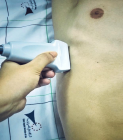
Figure 1
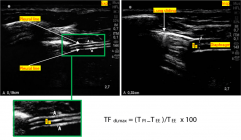
Figure 2
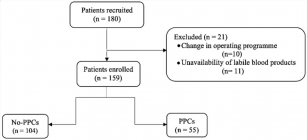
Figure 3
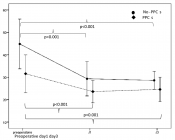
Figure 4
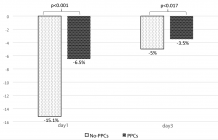
Figure 5
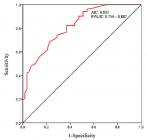
Figure 6
Similar Articles
-
Lateral Pancreato-Jejunostomy in Chronic Pancreatitis: An appraisal of 32 casesSardar Rezaul Islam*,Shafiqur Rahman,Shaurav Talukdar,Shah Alam Sarkar,Shah Poran,Mushfiqur Rahman. Lateral Pancreato-Jejunostomy in Chronic Pancreatitis: An appraisal of 32 cases. . 2020 doi: 10.29328/journal.ascr.1001043; 4: 001-005.
-
The Predictive Value of Diaphragm Thickness Fraction on Postoperative Pulmonary Complications after Digestive Cancer Curative SurgeryOussama Ssouni*, Abdelilah Ghannam, Brahim El-Ahmadi, Zakaria Belkhadir, Khalid Abidi, Amal Bouziane, Redouane Abouqal. The Predictive Value of Diaphragm Thickness Fraction on Postoperative Pulmonary Complications after Digestive Cancer Curative Surgery. . 2023 doi: 10.29328/journal.ascr.1001072; 7: 035-045
Recently Viewed
-
The Accuracy of pHH3 in Meningioma Grading: A Single Institution StudyMansouri Nada1, Yaiche Rahma*, Takout Khouloud, Gargouri Faten, Tlili Karima, Rachdi Mohamed Amine, Ammar Hichem, Yedeas Dahmani, Radhouane Khaled, Chkili Ridha, Msakni Issam, Laabidi Besma. The Accuracy of pHH3 in Meningioma Grading: A Single Institution Study. Arch Pathol Clin Res. 2024: doi: 10.29328/journal.apcr.1001041; 8: 006-011
-
Assessment of Perceptions of Nursing Undergraduates towards Mental Health PracticesAlya Algamdii*. Assessment of Perceptions of Nursing Undergraduates towards Mental Health Practices. Clin J Nurs Care Pract. 2025: doi: 10.29328/journal.cjncp.1001059; 9: 007-011
-
Multipurpose Antioxidants based on Food Industry Waste: Production and Properties EvaluationToshkhodjaev*. Multipurpose Antioxidants based on Food Industry Waste: Production and Properties Evaluation. Arch Food Nutr Sci. 2025: doi: 10.29328/journal.afns.1001062; 9: 001-003
-
Relationship between Fertility Diet Score Index Items and Ovulation in Women with Polycystic Ovary Syndrome: A Narrative ReviewHadis Alimoradi,Faezeh Mashhadi,Ava Hemmat,Mohsen Nematy,Maryam Khosravi,Maryam Emadzadeh,Nayere Khadem Ghaebi,Fatemeh Roudi*. Relationship between Fertility Diet Score Index Items and Ovulation in Women with Polycystic Ovary Syndrome: A Narrative Review. Arch Food Nutr Sci. 2024: doi: 10.29328/journal.afns.1001061; 8: 041-048
-
Evaluation of the LumiraDx SARS-CoV-2 antigen assay for large-scale population testing in SenegalMoustapha Mbow*,Ibrahima Diallo,Mamadou Diouf,Marouba Cissé#,Moctar Gningue#,Aminata Mboup,Nafissatou Leye,Gora Lo,Yacine Amet Dia,Abdou Padane,Djibril Wade,Josephine Khady Badiane,Oumar Diop,Aminata Dia,Ambroise Ahouidi,Doudou George Massar Niang,Babacar Mbengue,Maguette Dème Sylla Niang,Papa Alassane Diaw,Tandakha Ndiaye Dieye,Badara Cisé,El Hadj Mamadou Mbaye,Alioune Dieye,Souleymane Mboup. Evaluation of the LumiraDx SARS-CoV-2 antigen assay for large-scale population testing in Senegal. Int J Clin Virol. 2022: doi: 10.29328/journal.ijcv.1001041; 6: 001-006
Most Viewed
-
Feasibility study of magnetic sensing for detecting single-neuron action potentialsDenis Tonini,Kai Wu,Renata Saha,Jian-Ping Wang*. Feasibility study of magnetic sensing for detecting single-neuron action potentials. Ann Biomed Sci Eng. 2022 doi: 10.29328/journal.abse.1001018; 6: 019-029
-
Evaluation of In vitro and Ex vivo Models for Studying the Effectiveness of Vaginal Drug Systems in Controlling Microbe Infections: A Systematic ReviewMohammad Hossein Karami*, Majid Abdouss*, Mandana Karami. Evaluation of In vitro and Ex vivo Models for Studying the Effectiveness of Vaginal Drug Systems in Controlling Microbe Infections: A Systematic Review. Clin J Obstet Gynecol. 2023 doi: 10.29328/journal.cjog.1001151; 6: 201-215
-
Prospective Coronavirus Liver Effects: Available KnowledgeAvishek Mandal*. Prospective Coronavirus Liver Effects: Available Knowledge. Ann Clin Gastroenterol Hepatol. 2023 doi: 10.29328/journal.acgh.1001039; 7: 001-010
-
Causal Link between Human Blood Metabolites and Asthma: An Investigation Using Mendelian RandomizationYong-Qing Zhu, Xiao-Yan Meng, Jing-Hua Yang*. Causal Link between Human Blood Metabolites and Asthma: An Investigation Using Mendelian Randomization. Arch Asthma Allergy Immunol. 2023 doi: 10.29328/journal.aaai.1001032; 7: 012-022
-
An algorithm to safely manage oral food challenge in an office-based setting for children with multiple food allergiesNathalie Cottel,Aïcha Dieme,Véronique Orcel,Yannick Chantran,Mélisande Bourgoin-Heck,Jocelyne Just. An algorithm to safely manage oral food challenge in an office-based setting for children with multiple food allergies. Arch Asthma Allergy Immunol. 2021 doi: 10.29328/journal.aaai.1001027; 5: 030-037

HSPI: We're glad you're here. Please click "create a new Query" if you are a new visitor to our website and need further information from us.
If you are already a member of our network and need to keep track of any developments regarding a question you have already submitted, click "take me to my Query."







